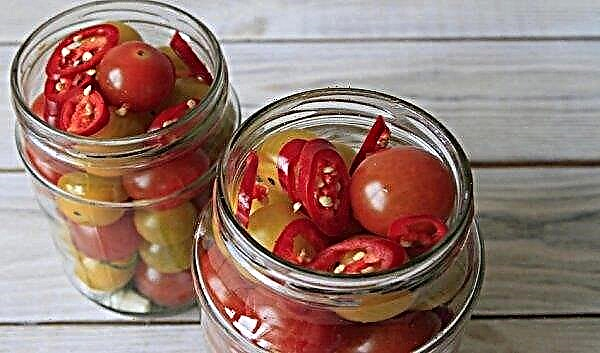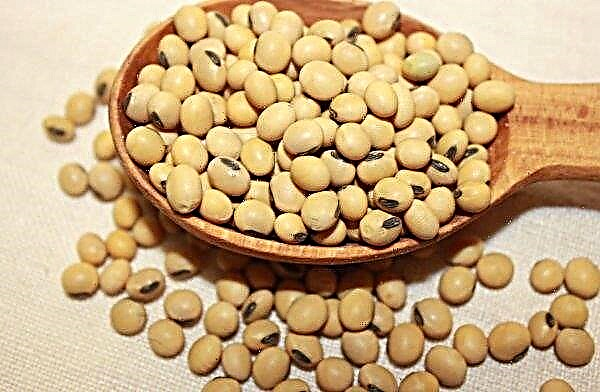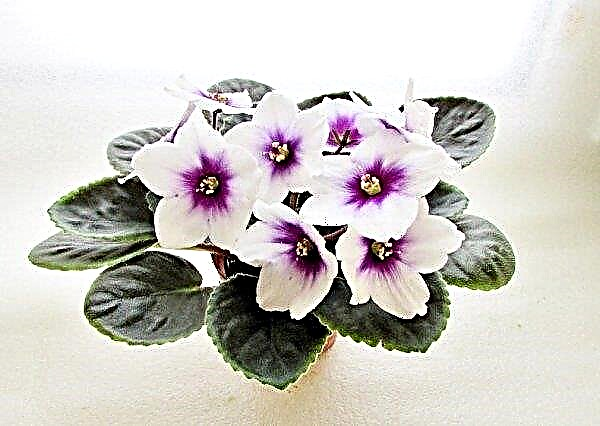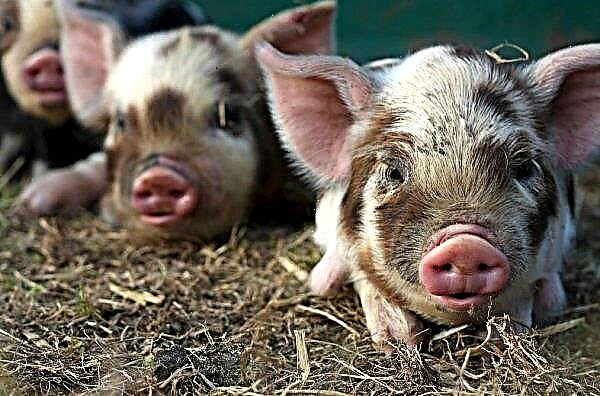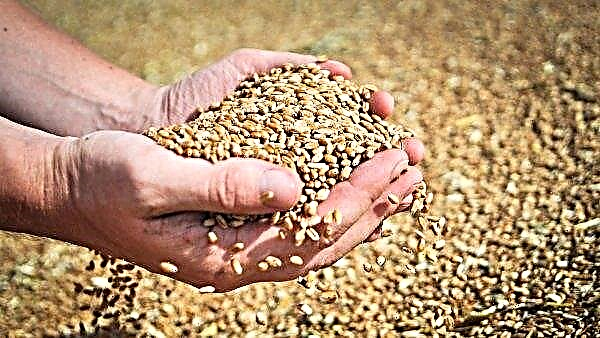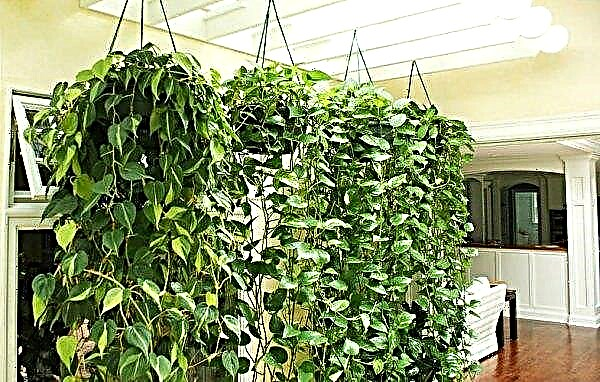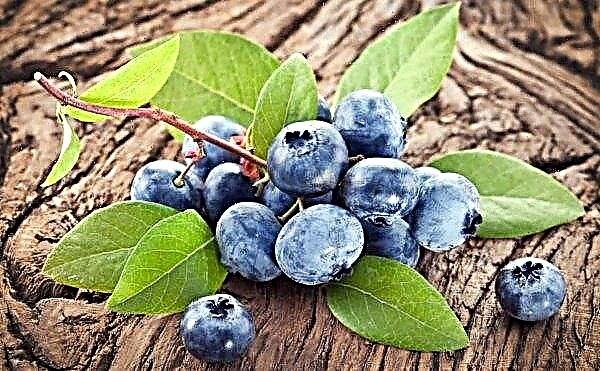Those gardeners whose plots of vegetables are far away, and there is no possibility of daily harvesting, will be interested in hybrids of carpal tomatoes. One of them is Rhapsody F1, which will be discussed in the article.
Selection history
Rhapsody tomatoes include North, Raspberry, Golden and Rhapsody NK. The last hybrid will be discussed. This is a product of Russian selection. Initially, the plant was intended for greenhouse cultivation, since it is tall and is a hybrid. But later its cultivation in the open ground began to be successfully practiced.
Did you know? The designation “F1” indicates that it is a hybrid of the first generation (translated from Italian “filli” — these are kids"). The seeds of such plants are not collected on their own, but are produced every year anew. One specialist through genetic crosses per year receives only 3 or 4 kg of such seeds.
Characteristic and Description
Rhapsody NK F1 is classified as carpal tomato. This means that the harvest is harvested with brushes (the fruits ripen almost simultaneously), although it is possible with individual fruits.
Productivity
The hybrid belongs to early ripe tomatoes, therefore, finished products can be obtained within one and a half to two months after transplanting seedlings. Good yield is explained by the high growth of plants, as well as a sufficient number of brushes, each of which forms up to 7 fruits. From one plant, with proper care, you can collect from 4 to 5 kg of tomatoes and from 30 to 40 kg from 1 m².
Description of the fetus
Tomatoes have a flat round shape. The weight of the fetus can reach 140 g. The skin is bright red, although thin, but quite dense and resistant to damage. The pulp is juicy and fleshy, with 3 or 4 seed chambers, has a pleasant sour taste.
The fruits are used fresh, as well as for preservation (except for the first harvest), the preparation of juices, salads and sauces.
Pros and Cons of the Hybrid
- For Rhapsody NK F1, the presence of such advantages is characteristic:
- bushes are strong and vigorous;
- high yield and almost simultaneous ripening of berries on the brush;
- the length of the internodes is up to 15 cm; therefore, the number of brushes is greater than that of other tall hybrids;
- the fruits are the same in size within not only the brush, but also the entire bush;
- the skin is resistant to cracking;
- ripened berries can be on the bush for a long time, not overriding and not crumbling;
- shows good adaptation to climate change;
- It is resistant to fusarium, brown spotting, verticillosis and tobacco mosaic.
- But at the same time, the plant has some disadvantages:
- since this is a hybrid, it is not possible to independently harvest seeds, so they need to be bought annually. Their price is higher than the cost of varietal seeds;
- the fruits are not intended for too long transportation;
- necessary stepsoning and formation of bushes;
- with prolonged storage, they somewhat lose their original taste.
Optimal growing time
Sowing seeds of tall tomatoes is made a little earlier than undersized - 50--60 days before transplanting seedlings in open ground. Usually this time falls on the last days of March or the beginning of April. When steady heat occurs (not lower than + 10 ° С), seedlings can be planted in a permanent place. Most often this happens in late May or early June.
The basic rules of growing
In order for the expended work to be more than paid off, you need to properly care for seedlings, and in the future for adult specimens.
Growing seedlings
Seed products of Rhapsody are most often coated, but if it is absent, then pre-sowing preparation can be carried out:
- soak for a day in an ash solution (2 tbsp. l. per 1 liter of warm water);
- Hold for 10 hours in a solution of a growth stimulator (Zircon or Albit);
- day hold on the bottom shelf of the refrigerator.
Sowing seeds is carried out in several stages:
- To fill boxes or containers of small sizes with the soil mixture (garden soil, humus, peat and sand in equal proportions).
- Water the soil and spread the seeds. Sprinkle on top with the same mixture, sand or peat chips (the layer should not be thicker than 1.5 cm).
- Cover the crops with foil to accelerate germination and reduce moisture evaporation. During germination, it is important to maintain air temperature at + 22 ... + 24 ° С.
 In the future, seedlings require the following care:
In the future, seedlings require the following care:- when hooks of seedlings appear, the film is removed;
- so that the sprouts do not stretch, it is necessary to organize lighting for more than 14 hours a day;
- daytime temperature is maintained at + 20 ° С, and nighttime temperature is about + 16 ° С;
- moderate watering is needed so that the top layer dries out a little (about 2 times a week). With waterlogging, there is a threat of black leg disease;
- after the appearance of 2 real leaves, seedlings need to be dived. Plants are planted in separate containers (plastic glasses or peat pots), which fill the soil with the same composition that was used for the previous planting;
- fertilizing seedlings is not necessary - before planting in a permanent place it will have enough nutrients;
- two weeks before the seedlings are planted, they begin to accustom them to environmental conditions. These procedures are carried out at a temperature of + 10 ° C (not lower). The duration of hardening is gradually increasing.
Important! Of great importance is the teaching of seedlings not only to air temperature, but also to the sun's rays, which are also a great stress for her.
Preparation of a plot for planting seedlings
Before transplanting seedlings to a permanent place, you need to consider the following nuances:
- It is important to determine its location. Tomatoes love the sun, so you need to choose the appropriate areas. Plant tomatoes well after cucumbers, onions or carrots. The bad predecessors are nightshade, as they have common diseases and pests.
- The land should be cultivated twice. In autumn, the remains of plants are removed, plowing or digging is carried out, and in spring, the beds are dug up with a shovel or pitchfork and harrowed.
- Poor soils should be fertilized. Before the autumn treatment, humus (about 5 kg per 1 m²) and mineral fertilizing (40 g of superphosphate + 20 g of potassium salt per 1 m²) are added. In spring, rotted bird droppings and ash (1 kg / m² each), as well as ammonium sulfate (20 g / m²) are introduced.

Seedling Planting Technology
You can plant seedlings in rows against each other or in a checkerboard pattern. Basically, the technology is practically no different from planting other varieties and hybrids:
- the distance between the bushes is about 0.5 m, and between the rows - up to 0.7 m;
- the holes should be larger than an earthen coma with roots. A liter of water is poured into each hole;
- the stem should be sprinkled with earth a little higher than it was before, which stimulates the additional formation of roots. Some gardeners even advise picking off the lower leaves to plant the tomato deeper;
- the earth around the seedling needs to be compacted and watered a little more;
- the soil around the stem can be mulched with any suitable material (for example, peat);
- if the sun is too scorching, planted plants need to be shaded.
Culture Care Features
The care for tall and short tomatoes is different: since indeterminate (tall) specimens do not have growth restrictions, there are some peculiarities when caring for them.
Watering Rules
Tomatoes tolerate drought better than waterlogging, provoking their poor growth and the occurrence of diseases.
At the same time, there are important points:
- water the plants once a week, spending on each bush about a liter of water;
- in rainy weather or drought, certain adjustments are made to the irrigation schedule;
- the optimal time for watering is considered the second half of the day;
- such procedures are very important when flowering the first brushes;
- before loosening and after applying top dressing (dry), tomatoes also need moisture;
- The use of drip irrigation gives good results.

Top dressing
Tomatoes are demanding fertilizers, but do not like their overabundance.
- If in the spring fertilizers were not applied to the soil, then the first top dressing is carried out 2 weeks after transplanting. On a bucket of water take 1 part of the mullein (about 1 kg), as well as 20 g of superphosphate. 500 ml of solution is poured under each bush.
- The second feeding is carried out 3 weeks after the first. Dry fertilizers are used for it (20 g of superphosphate, 15 g of potassium salts and 10 g of ammonium nitrate per 1 m²). It can be combined with hilling.
- A third fertilizer application is not necessary if the foliage on the tomatoes has a saturated green color, and the fruits are well tied and ripen. If there are problems, they bring the same drugs as in the second top dressing.
Important! An excess of nitrogen fertilizers increases the growth of green mass and inhibits flowering and fruiting. Nitrogen is important in fruit ripening, and potassium is needed to increase sugar content.
Pasynkovka and formation of a bush
Bushes of indeterminate hybrids need garter and formation:
- start tying tomatoes already under 2–4 leaves. Stakes are driven in from the north side, 10 cm from the base of the bush. Trellis can also be used for tying;
- the bush is formed into 1 or 2 stems, and all the others are removed. The stepsons break off to the bottom - they leave “hemp” 1-1.5 cm long so that the sleeping kidneys do not wake up and the growth of new stepsons does not begin;
- growth of bushes after reaching a height of about 2 m should be limited. To do this, pinch the top - then the nutrients are sent to the ripening of the fruits, and not to the growth of the stem and leaves;
- for too large and heavy brushes, additional garter may be required;
- if harvesting is carried out with brushes, then their normalization is needed. It consists in the fact that 6-8 ovaries are left on the inflorescence, and the rest are removed.

Soil cultivation and weeding
Tomato bushes, like most plants, prefer loose soil without weeds, therefore:
- weeds need to be removed regularly, as they absorb the nutrients needed by tomatoes, and also contribute to the resettlement and spread of many pests;
- loosening of the soil between the rows should be carried out every 10-15 days. The use of mulching materials will simplify this task and slow down the growth of weeds;
- Tomatoes need hills to form additional roots. The first is carried out 2 weeks after planting, the second - 20 days after the first. Before starting work, plants need to be well watered.
Pests and Diseases of the Rhapsody Hybrid
Since hybrids have genetic resistance to most diseases, they do not need to be treated with chemicals. For example, they are also resistant to aphids, but can be attacked by slugs. To prevent their appearance, the soil is sprinkled with wood ash and sand, and the tomatoes themselves are dusted with ash. If pests have already appeared, then you need to collect them manually. For preventive purposes, the following methods are used:
For preventive purposes, the following methods are used:
- ensuring good ventilation between the bushes (do not thicken the planting);
- soil loosening;
- removal of plant residues from the previous crop;
- can be sprayed with soda solution (200 g per 10 l) or whey (0.5 l per 10 l of water). This will also serve as additional fertilizing.
Harvesting and storage
There are some features in the harvesting and storage of carpal tomatoes:
- the brushes are cut off entirely (the cut is done at the base) or gently break off individually;
- for longer storage, the fruits do not separate from the stalks;
- also extends the shelf life of collecting brushes with unripened fruits (mature 2-3 first fruits). The remaining berries ripen in 4–5 days;
- rapid cooling of the fruit to + 12.5 ° C also helps to prolong storage - it reduces moisture loss and slows down ripening. Containers with tomatoes should be free to provide good ventilation. However, prolonged maintenance at low temperature degrades the taste of the product;
- ripe fruits are stored for about 10 days, and unripe - up to 4-5 weeks;
- the optimum storage temperature for ripened fruits is + 10 ... + 12 ° С, and humidity - about 80%.
Did you know? Unusual carpal tomatoes include the tomato tree Octopus F1. This plant reaches a height of 4 meters, and the area of its crown can grow up to 40–50 m². Up to 1.5 tons of crops (about 14,000 fruits) can be harvested from such a giant per year.
When growing your own crop of tomato Rhapsody NK F1, you need to follow the rules outlined in the article, and the plant will be able to please you with tasty and healthy fruits.


